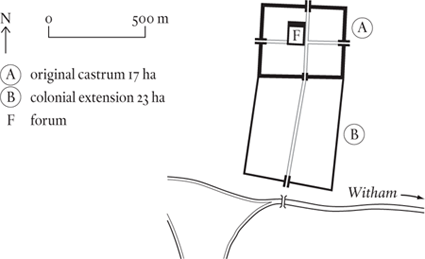
Lincolnshire, England
Classical Lindum; Roman colony, probable capital of one of the late Roman provinces of Britain
Lincoln has its origins in a legionary camp laid out by IX Hispana sometime around AD 60. The layout was standard, but the scale is a bit smaller than usual, the enclosed area being seventeen hectares, compared to the typical twenty hectares. When IX Hispana moved north to YORK, II Adiutrix took its place at Lincoln (early 70s to late 80s), and following the departure of II Adiutrix for the continent it became a colony for discharged veterans.

Little is known about Roman Lincoln except that it was reasonably successful. Whereas the comparable Roman foundation at Gloucester remained confined to the pre-existing legionary camp, Lincoln soon boasted a suburb as big as the city itself. At the end of the second century the city wall was extended to take in the suburb; together, the old and new towns had an area of forty hectares, a figure that puts Lincoln in the middle rank of British cities. Two things suggest that it occupied a rather higher position in the ranking than its area would indicate. The first is that it had outgrown its original perimeter; some towns of comparable size, like SILCHESTER, had arrived at the same figure by a process of contraction. The second is that it seems to have been chosen as the capital of one of Diocletian’s new British provinces when the two existing ones were divided into four, c. AD 300. This isn’t absolutely certain, but the balance of probabilities is in favour and makes it likely that Lincoln achieved a larger population and held on to it longer than most British towns. Something of the order of 4,000 in the third century, and 2,000 at the beginning of the fifth, seem reasonable guesses. The end of Roman Lincoln is therefore likely to have been precipitous even by British standards, for no one would claim that it contained a significant population when the fifth century ended.
Lincoln didn’t exist as an urban unit during the Dark Ages, but the late eighth and early ninth centuries saw the site repopulated and by the time of the Domesday survey in 1086 it had a population of about 5,000, enough to give it a respectable fifth place in the Norman kingdom’s urban hierarchy. In the later Middle Ages Lincoln slipped down a couple of places, despite an increase in its population to 6,000 to 7,000. These fairly reliable figures, from a time when Britain had three or four times the population it had in the days of the Roman province, suggest the proposed maximum for the colonia of Lindum is not ungenerous. It also fits with the fact that the Roman circuit proved too small for the medieval population: by the mid fourteenth century there were suburbs of varying size outside all the city gates.